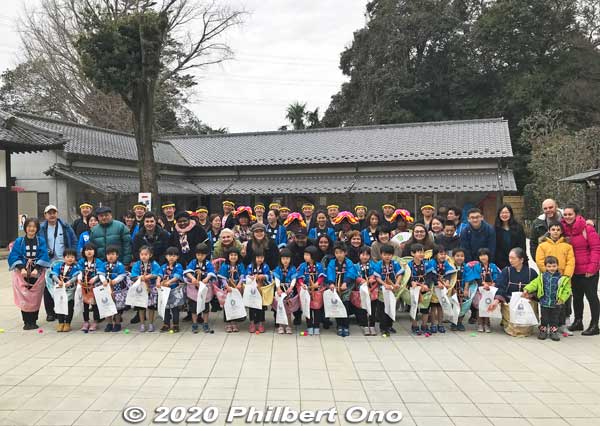
Updated: April 19, 2021
*Update: To prevent the spread of coronavirus, the Saitama Homestay Program in 2021 has been canceled. Online Zoom meetings will be held instead.
Saitama Prefecture is next to Tokyo and home to four venues of Tokyo 2020: Saitama Super Arena (basketball) and Saitama Stadium (football/soccer) in Saitama city, Asaka Shooting Range (shooting) in Asaka, and Kasumigaseki Country Club (golf) in Kawagoe.* Spurred by this Olympic connection, Saitama Prefecture is now offering free homestays to non-Japanese having a connection to the Tokyo 2020 Olympics/Paralympics. Homestay guests can be Games volunteers, family members of Olympic/Paralympic athletes, Olympic/Paralympic officials, NOC/NPC members, foreign correspondents, etc. Basically, up to three people can stay with a host family for a maximum of three nights. So you can homestay as a single person, as a couple, with a friend, parents with a child, siblings, etc.
I was told that the maximum number of guests and maximum nights can be flexible depending on the host family. For example, it may be possible for a family of four (two parents and two children) to be hosted. It’s also possible to homestay longer by changing your host family after three nights and staying with a different host family for up to another three nights. (It might be possible to stay with the same host family for more nights too.)
The homestay program is mainly for a “Japanese family life experience” rather than being a lodging service. Free dinner and breakfast are provided by the host family. You can indicate preferences for food, pets, non-smoking, etc. You will have your own private room in the host family’s home.
You only pay for your round-trip transportation to Saitama (cheap from Tokyo) and for lunch and other personal expenses during daytime excursions. Although the homestay program is mainly for the Tokyo 2020 period (in 2021), qualified foreigners can apply for and do a homestay in Saitama right now.
People traveling from overseas may want to do the homestay right before or after the Games or in-between the Olympics and Paralympics. Scheduling might be less hectic during such times. Just one or two nights would be fine for tight schedules too. The Saitama homestay program will end after the Paralympics in Sept. 2021.
Saitama wants to promote their prefecture to overseas people and have their citizens make more international friends. From Aug. to Nov. 2018, Saitama recruited about 670 homestay host families. The homestay program then started in April 2019 with some foreigners living in Japan being invited for a homestay and local tour in various cities/towns of Saitama. It’s a great opportunity to meet a Japanese family and get a glimpse of Japanese home life.
Saitama has 60 cities and towns and you can request which city/town to homestay and they will try to place you there or near there. You can also email your host family in advance and decide what to do during your stay. Saitama has lots to see and do, so you have a very wide choice.
As of this writing, Saitama is the only prefecture with an official homestay program geared for the Games. Tokyo, Chiba, and Kanagawa do not seem to have homestay programs organized by the local government. So I have to give credit to Saitama Prefecture for this bold initiative.
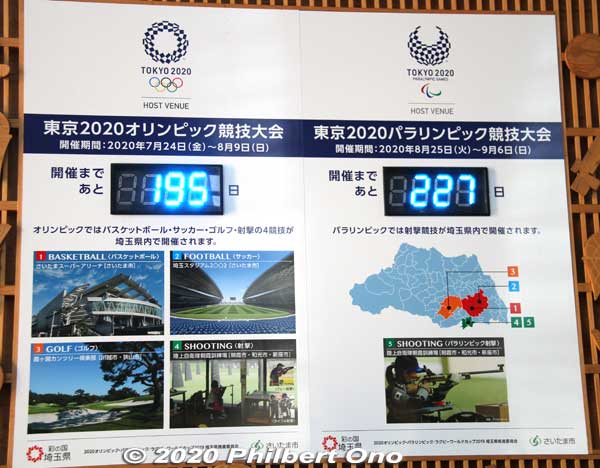

During a weekend in mid-January 2020, I was one of 16 foreigners invited by Saitama Prefecture for an overnight homestay with local families in the cities of Okegawa and Ageo (about 45 min.–50 min. by train from Tokyo Station on the JR Takasaki Line or Tokyo-Ueno Line). We came from many different countries like Canada, Australia, Belgium, China, Romania, India, Romania, Turkey, the Maldives, and even Malawi. I was the only American. Most people were Tokyo-based embassy staff from various countries. I was the only Games volunteer. Very nice meeting everyone, and we all got along very well. (We’re in the top photo posing with Okegawa Tanpopo Nursery School performers who welcomed us.)

During our two-day homestay, we toured a few places as a group by private bus and also spent time with host families in the evening and morning. As a group, we toured Saitama Super Arena (near Saitama Shin-toshin Station) and watched women’s semi-final basketball games (Empress’s Cup), had lunch at Benibana Furusato-kan Hall in Okegawa, and went to the neighboring town of Kawajima to visit Toyama Memorial Museum and the Kinbue Syoyu Park soy sauce factory (photos below). Note that this was a special group tour only for us, so during your homestay, your host family will plan or recommend a custom tour for you based on your preferences. You might also be staying in a different city/town in Saitama.
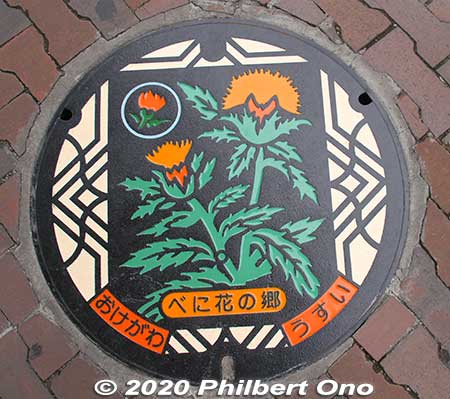
I stayed with a young family of three in Okegawa (桶川市), a small city of 74,000 about 48 min. by train from Tokyo Station. My host family was great. It was their first time to be a host family and it was also my first time to do a homestay in Japan with someone who wasn’t a relative or friend or business.

A few days before my homestay, I emailed the host father in English. We talked about food preferences (I can eat anything) and what we should do during my free time. I told him that I wanted to see the old lodging town of Okegawa-juku (桶川宿). Okegawa happens to be a shukuba lodging town (宿場) on the old Nakasendo Road connecting Tokyo (Nihonbashi) and Kyoto during the Edo Period (1603–1868). I’m a Nakasendo fan so I like to visit towns on the Nakasendo. We never exchanged photos of each other before meeting, so we didn’t know what each other looked like until we met. Fortunately, we hit it off and got along very well.
I was surprised that my host family couldn’t speak English. I thought the homestays were supposed to be a chance for host families to speak English, but non-English-speaking families can also be hosts. Well, it didn’t matter because I speak Japanese.
My host family had a darling daughter in the 1st grade who was taking weekly English lessons and knew some basic English words. She also played an instrument called the taisho-goto (大正琴). It’s a string instrument with numbered keys that you press to produce different notes. She sweetly played two songs for me, the Japanese national anthem and a children’s song.
They had their own house and I had my own tatami mat room and futon. Dinner was at a restaurant, and breakfast was home-cooked by the mother. We got along very well and talked a lot. They were surprised that I had already visited many places in Saitama, but luckily I had never been to Okegawa. We also talked about my home state since they honeymooned there (Hawaiʻi). They were relieved that I could speak Japanese. I was amazed at how people could be so nice and friendly to someone they’ve never met before.
The other foreign guests also had a great time with their host families. I could tell the families (especially the kids) were really happy to meet a foreigner and would miss their foreign guest. The homestay is a great way to meet a local Japanese family. Once they meet you, Japanese host families can be very friendly and very hospitable.

Since this homestay program is conducted by the Saitama Prefectural Government, it’s free and different from for-profit homestays. The host family is really doing it from the kindness of their hearts, not for profit. They want to meet you and befriend you. This means your host family can easily become a long-term friend in Japan after your homestay ends, especially if the family has kid(s). (You’ll love the kids.) Always nice to have friends in Japan. I think this is the greatest side benefit of a non-profit homestay. I know I’ll be keeping in touch with my host family. My host family has now been inspired to study English and wants to host more foreign guests.

After a good night’s sleep and breakfast, my host family drove me to Okegawa-juku which I wanted to visit. Okegawa-juku was the sixth lodging town (shukuba 宿場) on the old Nakasendo Road (中山道) that connected Tokyo (Edo) and Kyoto through an interior route passing through Saitama, Gunma, Nagano, Gifu, and Shiga Prefectures. About 526 km long, the Nakasendo had 69 lodging towns where travelers could lodge and water their horses during the Edo Period (17th to 19th centuries) before trains and cars were invented. Saitama had nine of these Nakasendo lodging towns and Okegawa-juku was one of them. The area that was Okegawa-juku still has a few traditional buildings from the old days. On foot from Tokyo (Nihonbashi Bridge) to Okegawa in the old days was about the same distance as a full marathon. So it would take a day to reach Okegawa from Tokyo. Today, Okegawa-juku is a short walk from JR Okegawa Station.

The Nakasendo Road still runs through Okegawa, and we visited a few Okegawa-juku buildings. First we went to the Okegawa Tourist Association (桶川市観光協会) in the Nakasendo Shukuba-kan (中山道宿場館) building right in the middle of the former lodging town. They have volunteer tour guides for the shukuba area and we had two guides who showed us around on foot (no English). Since I didn’t have much time, we only saw the main buildings in Okegawa-juku, not everything.
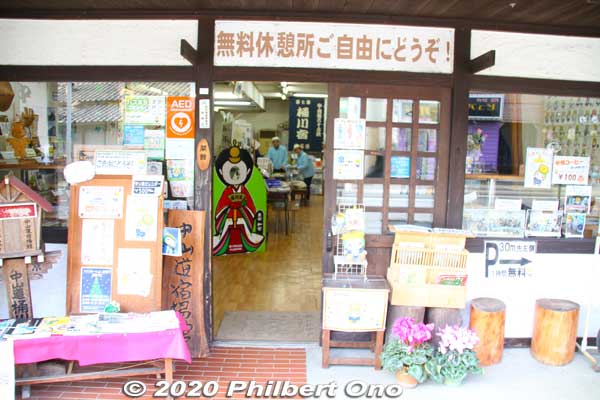
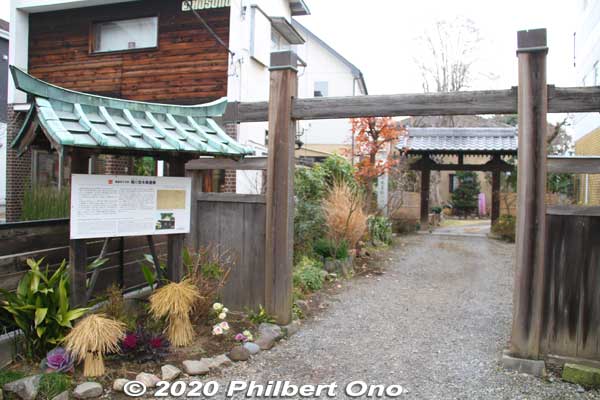
Each shukuba lodging town on the Nakasendo had buildings for a specific purpose. The most important one was the Honjin luxury lodge (本陣) where VIP travelers like the emperor, daimyo, shogun, Imperial princess, etc., stayed. Only part of Okegawa’s Honjin remains today, but it is private property and normally not open to the public. We could only see the entrance gate (photo above).
During its heyday, Okegawa-juku saw VIP guests such as the Maeda daimyo from Kaga (Ishikawa Prefecture) and Lord Tokugawa Nariaki (1800–1860) from Mito (Ibaraki Prefecture). But the most famous dignitary to stay in Okegawa was an emperor’s daughter named Princess Kazunomiya (1846–1877) when she was traveling from Kyoto to Tokyo to marry shogun Tokugawa Iemochi. She lodged in Okegawa on Nov. 13, 1861 and her entourage numbered over 30,000. Today, Okegawa holds an annual autumn festival called Okegawa Shimin Matsuri (桶川市民まつり) on Nov. 3 (national holiday) reenacting Princess Kazunomiya’s procession proceeding through Okegawa-juku. Emperor Meiji also once rested here while passing through in 1878 and there’s a stone marker for it at the Honjin gate.
Other shukuba buildings included Waki-Honjin for lesser VIPs, Hatago inns for regular travelers, logistics agents, teahouses, and shops. Okegawa-juku was about 1 km long with about 36 inns and a population of 1,444 by 1840. Okegawa-juku also had wooden gates that were opened in the morning and closed in the evening. Okegawa-juku’s neighboring Nakasendo towns were Ageo-juku and Konosu-juku.
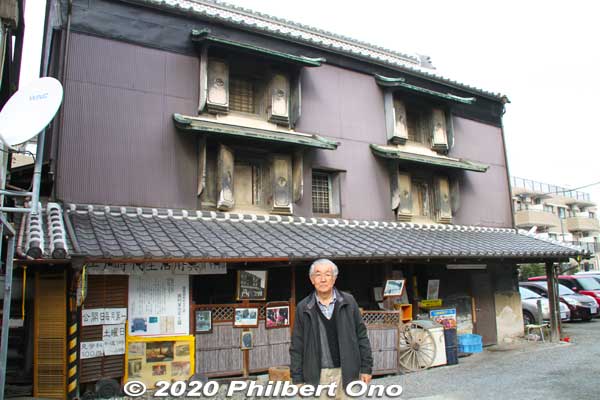
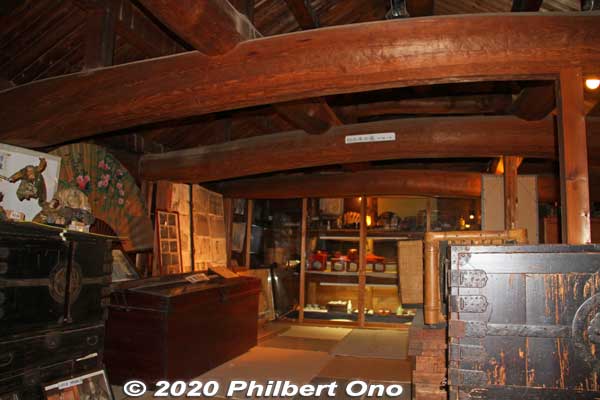
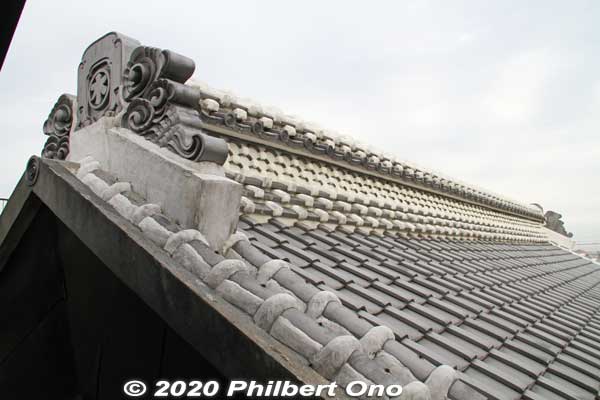
Perhaps Okegawa-juku’s most distinctive building is the Shimamura family storehouse (島村家住宅土蔵). It was built in 1836 as a three-story earthen storehouse to provide employment to local people suffering from a bad harvest that year. The storehouse is therefore nicknamed “Otasuke-zo” (お助け蔵) or “Savior Storehouse” for saving people from starvation. The building is filled with all kinds of antique items from the old days collected by previous generations of the Shimamura family. Amazing, eclectic collection.
The storehouse’s earthen walls exposed to the elements tend to deteriorate with time. Other similar earthen storehouses in Okegawa have been torn down because it was too expensive to repair, but this one still thankfully survives because corrugated tin sheets were used to cover the exterior walls to protect it from the elements. The storehouse is a National Tangible Cultural Property.
The Shimamura family storehouse is normally open only on the first Saturday of the month from 1:00 pm to 4:00 pm. However, groups and special guests can arrange to enter the storehouse on other days by appointment. Admission is ¥100. (Call the Okegawa Tourist Association in Japanese.)

More photos of Okegawa-juku: https://photoguide.jp/pix/thumbnails.php?album=1061
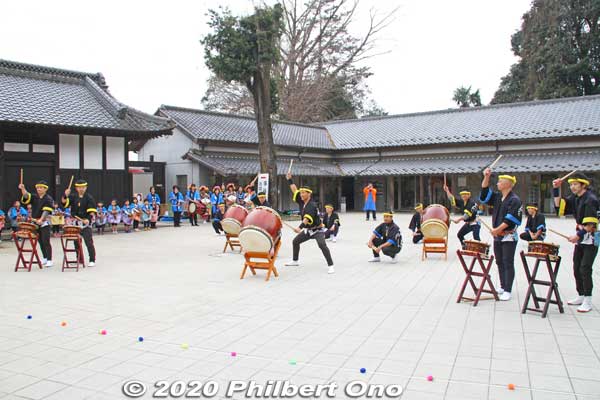
After my private morning tour of Okegawa-juku with my host family, all the foreign homestay guests met up at Okegawa Station for an afternoon group tour conducted by Saitama Prefecture. We traveled by private bus and first had a lunch stop at Benibana Furusato-kan Hall (べに花ふるさと館) in Okegawa. When we arrived, we were greeted by a wonderful dance and taiko drum performance by kids and parents from the local Okegawa Tanpopo Nursery School (桶川たんぽぽ保育園).

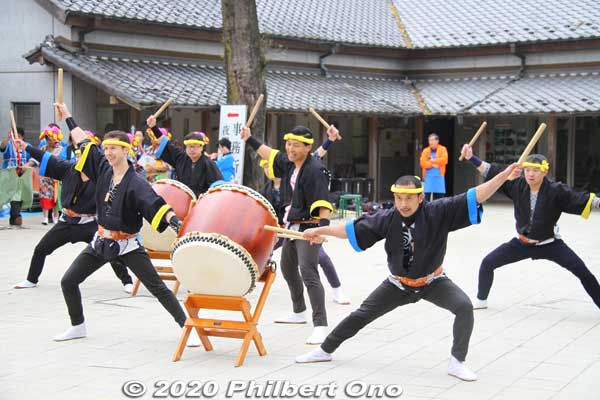
みなさん、ほんとうにありがとうございました。いろいろな国(くに)から来た(きた)我々(われわれ)はとても感激(かんげき)しました。
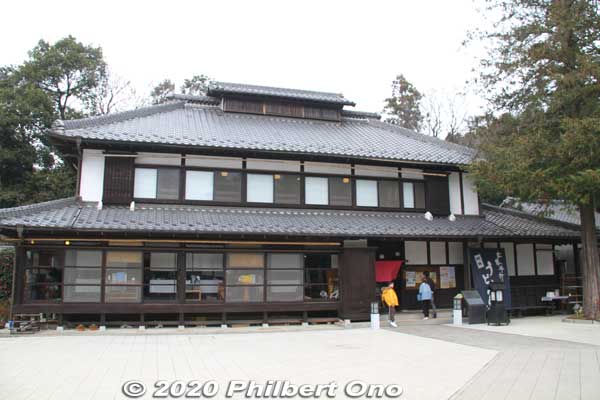

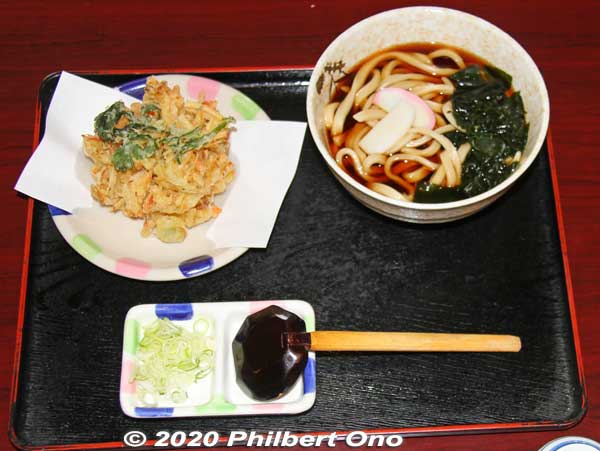
More photos of Benibana Furusato-kan and the kids performing: https://photoguide.jp/pix/thumbnails.php?album=1062
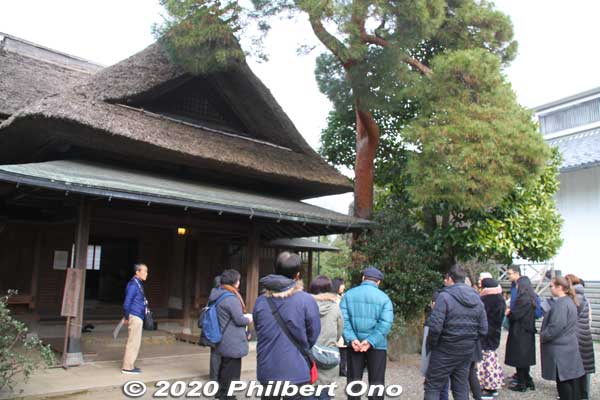
Next we visited Toyama Memorial Museum (遠山記念館) in the neighboring town of Kawajima (川島町). The highlight was this Japanese home built in 1936 by Kawajima-native Toyama Gen’ichi (遠山元一 1890–1972), the founder of Nikko Securities. It was a home for his mother.
The architect was Murooka Soshichi (室岡惣七). The house is very grand, very Japanese, and very aesthetic. Exquisite interior design with rare materials and artwork. The home has three wings each having a different architectural design. The home is now owned by the Toyama Memorial Museum Foundation and open to the public.

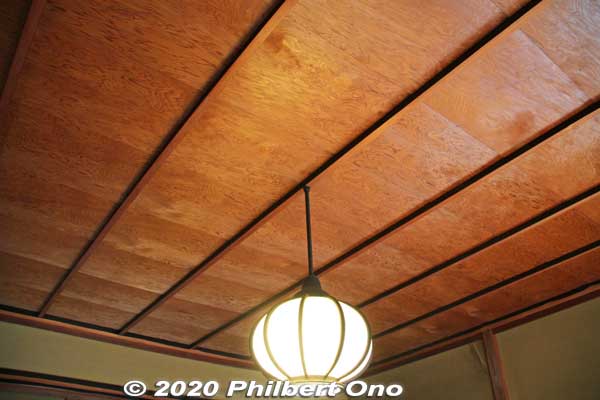

Inside Toyama Memorial Museum, we tried playing a traditional fan-tossing game called tosenkyo (投扇興). You toss a folding fan at a small target on a small block. Called “cho” (butterfly), the target is shaped like a gingko leaf. The number of points you earn depends on how well you knock down the target. It’s quite hard for beginners to even knock it down because the fan tends to fly in unpredictable directions.
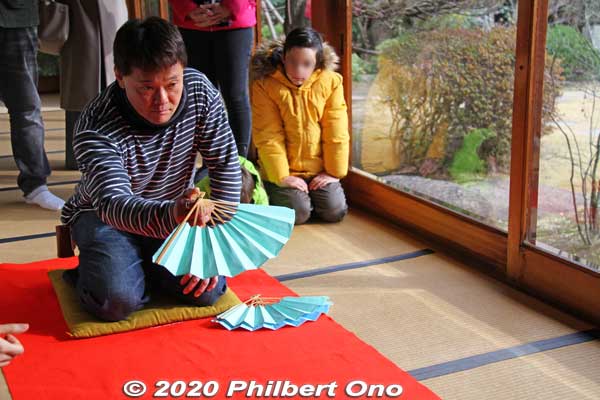
To get to Toyama Memorial Museum (official site) by public transportation, go to JR Okegawa Station and take a bus bound for Kawagoe Station. Get off at the Ushigayato bus stop and the museum is a 15-min. walk.
More photos of Toyama Memorial Museum: https://photoguide.jp/pix/thumbnails.php?album=1063
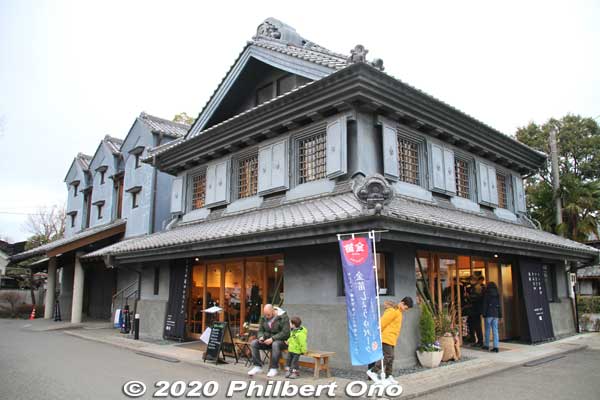
Our last stop of the tour was Kinbue Syoyu Park (金笛しょうゆパーク) for a soy sauce (shoyu) factory tour in Kawajima operated by Fueki Syoyu Brewing Co. (笛木醤油株式会社). Their shoyu products are sold under the “Kinbue” brand (金笛). They’ve been in business since 1789.
Our factory guide was Fueki Masatsugu, the 12th-generation proprietor of Fueki Syoyu Brewing Co. He has a very energetic personality. The factory tour started with him showing and explaining the ingredients used in making shoyu. Lots of soybeans and salt. We saw other buildings until we entered a room full of huge vats fermenting and aging the shoyu. The tour ended at their gift shop where you can buy their shoyu products and even have shoyu soft-serve ice cream. (Pretty good.) The factory is quite renown and has received much media coverage in Japan.
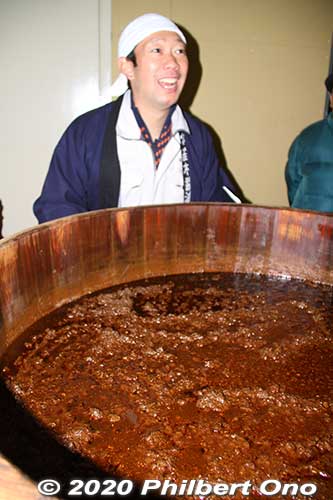
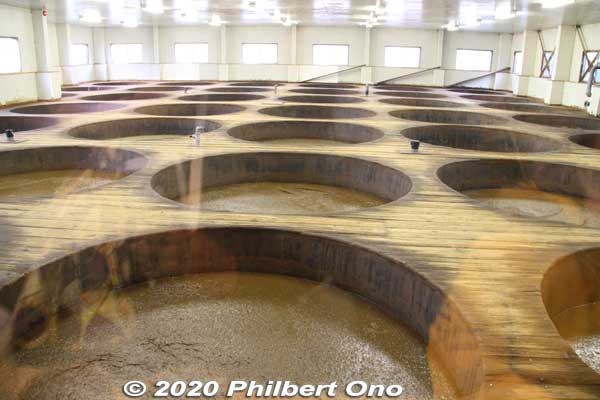
The factory tour takes at least 60 min. Call to make reservations for groups. You will need to bring your own Japanese-to-English interpreter. Getting there is kind of complicated, but there are buses from Kawagoe. Directions in Japanese. Website: https://kinbue-park.jp/
More photos of Kinbue Syoyu Park: https://photoguide.jp/pix/thumbnails.php?album=1064

Although Saitama Prefecture is not that well-known overseas, it has many interesting sights. The same goes for all of Japan’s 47 prefectures, famous or not. There’s always something interesting wherever you are in Japan. The trick is to be adventurous enough to discover them. Don’t fear the unknown. Saitama is well worth visiting, and you will surely find some unexpected delights.
Also, if you homestay in Saitama, you’ll have a local family taking you around. As you can see in my case, I had a great time meeting a local family and taking in some local sights and food. It’s the people you meet that make any trip the most memorable. 👏
*I wrote this blog post voluntarily because I think Saitama’s laudable homestay program deserves more attention and PR.
Saitama homestay info and application form here: https://www.pref.saitama.lg.jp/oly-para/eng/hospitality/homestay/guest-application.html
More photos of Saitama Prefecture: https://photoguide.jp/pix/index.php?cat=52
#saitamahomestay